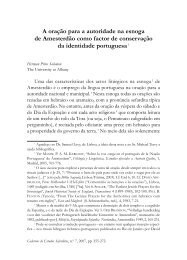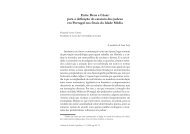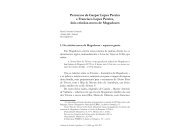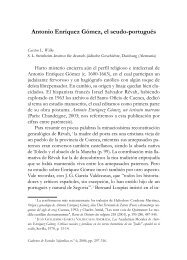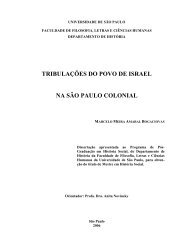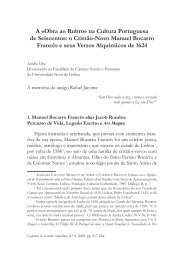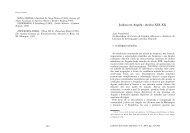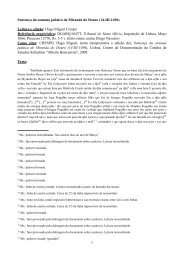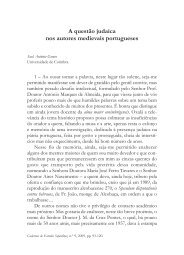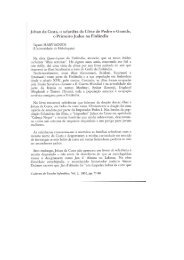Pagina 1-28.qxd - Cátedra de Estudos Sefarditas "Alberto Benveniste"
Pagina 1-28.qxd - Cátedra de Estudos Sefarditas "Alberto Benveniste"
Pagina 1-28.qxd - Cátedra de Estudos Sefarditas "Alberto Benveniste"
Create successful ePaper yourself
Turn your PDF publications into a flip-book with our unique Google optimized e-Paper software.
Pag 33-62:<strong>Pagina</strong> 1-<strong>28.qxd</strong> 10-12-2009 01:13 Page 40<br />
FRançOIS SOyeR<br />
tion and hence continued to represent a safe haven for converso fugitives<br />
even though, as we have seen above, the scarce documentary<br />
evi<strong>de</strong>nce indicates that the Portuguese authorities did arrest some<br />
conversos who illegally moved to the kingdom. Clearly, Isabel and<br />
Fernando could not continue to tolerate this situation.<br />
the presence of the Castilian conversos in Portugal emerged once<br />
more when discussions between Manuel and the Catholic Monarchs<br />
over his marriage to the Infanta Isabel began in earnest in<br />
1496. no evi<strong>de</strong>nce exists concerning the precise nature of the ins -<br />
tructions that the Portuguese King gave his representative but a<br />
marriage contract was finally drawn up on 30 november 1496 at<br />
Burgos in Castile. We are fortunate in that two i<strong>de</strong>ntical versions of<br />
the original marriage contract have been preserved in the vaults of<br />
the Torre do Tombo in lisbon and the Archivo General in Simancas. 12<br />
Contrary to the claims ma<strong>de</strong> by a number of historians, none of the<br />
twelve clauses of the marriage contract actually mention the expulsion<br />
of either the Jews or the “heretics” (i.e. conversos) as a precondition<br />
of the marriage. 13 It seems that Fernando and Isabel, as they<br />
were later to claim – and as we will see further below – received a<br />
separate promise from Manuel to expel the conversos and Jews. this<br />
promise was either an oral one ma<strong>de</strong> by his plenipotentiaries at<br />
Burgos or was ma<strong>de</strong> in a separate document that has either not yet<br />
been found by historians or which has perhaps not withstood the<br />
test of time. the surviving narrative evi<strong>de</strong>nce provi<strong>de</strong>s little helpful<br />
information. the Spanish chroniclers Bernál<strong>de</strong>z and Santa Cruz,<br />
for instance, do not connect the marriage negotiations and the <strong>de</strong>ci-<br />
12 For the document conserved in lisbon see a.n.t.t., Gaveta 17, maço 5, doc. 15. For<br />
the document preserved in Spain see a. De la tORRe and l. SUáRez FeRnánDez, Documentos<br />
referentes a las relaciones con Portugal durante el reino <strong>de</strong> los Reyes Catholicos, 3, 1–8, doc. 467.<br />
13 For the frequently repeated erroneous statement that the marriage contract of 30<br />
no vember 1496 contained a clause promising the expulsion of all Jews from Portugal see,<br />
for instance, a. lOSa, “le statut légal <strong>de</strong>s maures et <strong>de</strong>s juifs portugais pendant les xIIe-<br />
-xVe siècles”, Medievalia. Textos e <strong>Estudos</strong>, 5-6 (1994), 307; F. PORtUgal, ‘O problema<br />
judaico no reinado <strong>de</strong> D. Manuel’, offprint of Armas e Troféus, 3, (1975), 7.<br />
40



